Japan’s Cadastral Census of Korea
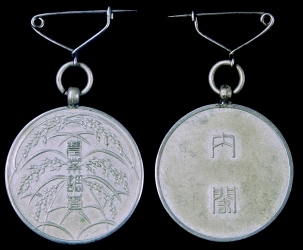
Japan established a protectorate in Korea in 1905 and annexed the peninsula in 1910. In order to exploit their new colony, the Japanese government in Korea needed detailed information on every facet of Korea. A cadastral survey establishes real property boundaries. Also, important is a triangulation survey, which establishes longitudinal and latitudinal grid coordinates. Without grid coordinates, the accuracy of the cadastral survey would be questionable. In Korea, a key component of the cadastral and triangulation surveys was that all documentation proving land ownership was to be turned in to the Government General’s Provisional Land Survey Bureau within a specific time frame. Once the papers were submitted, and the land accurately surveyed and measured, then private ownership of the real property would be established. However, the Japanese created road blocks whereby most of the applications for recognition of ownership could not be processed and subsequently the real property in question, was taken over by the Government General. Through this process, considerable amounts of private land became the property of the Government General which, in turn, was sold to Japanese businessmen and Japanese settler colonists. In 1910, the Japanese controlled an estimated 7% of all the arable land in Korea. As the years progressed, this ratio steadily increased to approx 53%. By the late 1920s the Oriental Development Company (東洋拓殖株式會社, 동양척식주식회사), had bought one third of the arable land in the Korean Peninsula.1 In addition, the Forest Law of August 1911, placed all mountain forests under Government General control. In 1918, the Forest Survey Ordinance was issued, which greatly enlarged the mountain and forest areas under direct Government General ownership. These surveys became the legal foundation for economic exploitation and control of Korea.
The planning for the cadastral survey began in 1907, under the auspices of the Department of Finance. In 1908, the Yi Dynasty government borrowed approximately seventeen million yen to fund the survey. It was believed that the survey would take approx. seven years to complete. The government-general commenced the land survey shortly after the August 22, 1910, Annexation. The work was conducted by a newly established Provisional Land Survey Bureau. The official regulations of the land survey were set forth in Imperial Ordinance No. 361 (September 1910). As of 1911, the Provisional Land Survey Bureau was composed of 835 individuals and by 1915 the bureau had grown to its high watermark of 4,713 employees. The surveys were completed in 1918. On the Cadastral Census Takers Badge, the Obverse inscription is 農業調査 Agricultural Survey (농업조사). The Reverse inscription is 內閣 Ministry (내각)
The Japanese also did cadastral surveys in Taiwan (1898–1905), the Kwantung Leased Territory (1914–1924) and in Okinawa Prefecture (1898–1903). After World War II, the U.S. army saw Japanese military and colonial maps as pieces of important geographic intelligence. These maps eventually proved to have great significance, not only during the Korean War, but also during the Cold War.
The National Census 국세조사 國勢調査
A considerable amount of the information on this page was found on the War Relics Forum.
A bill to conduct a national census was passed in the Japanese Parliament in 1896, which led to the 1902 promulgation of laws to actually conduct these surveys. Japan’s first National Census was planned for 1905, but was postponed due to the Russo-Japanese War. The next census was planned for 1915, but was also aborted because of WWI. It wasn’t until 1920 that Japan was able to conduct its First National Census. By this time, Japan was firmly entrenched in Korea but because of the March 1st, 1919 demonstrations for independence, the 1920 census was postponed in Korea. The Japanese wanted to conduct a National Census every 5 years on October 1st. The 1945 census was cancelled due to World War II.
The 1920 Census Medal
Although the 1920 National Census did not take place in Korea, the reason for the following information will become clearer later on this page.
The 1920 Census Medal is the only Census Medal ever issued in Japan. It was given to official census takers and those employed by the census bureau. Preceding the census, Edict 358 issued on September 25, 1918, laid down Execution Regulations for the National Census and established a Temporary General Census Department to write up regulations for the census and conduct preparatory committee meetings.
After the census, on May 24, 1921, a memo from the Decorations Bureau addressed to the Prime Minister lauded the first National Census as a monumental feat that deserved to be celebrated by a medal. The birth of the Japanese Census system was in the Taika Era (大化の改新 Great Reform) of 646AD, and it was felt that the 1920 Census was a comparable, monumental event. On June 8, 1921, the proposal got endorsed by the cabinet and the Legislation Bureau and was signed by Emperor Taisho as Edict 272 on June 16, 1921.
The medal is circular, struck in bronze and has a leaf-shaped claw. The suspension is a laterally pierced cylinder. The obverse shows an official of the Taika Era with a brush in his right hand, a rolled family register/scroll in his left, standing before a table, all within a scalloped border representing the outline of a chrysanthemum crest. The reverse of the medal has the inscription 大正九年 / 国勢調査 / 記念章 / 十月一日 which translates as 9th Year of Taisho (1920) / National Census Survey / Commemorative Medal / 1st October. The medal was awarded in a paulownia wood case with a white fitted insert. Some 222,000+ medals were issued.
Due to the March First Movement of 1919, the 1920 Census was cancelled in Korea. The first census, under the Japanese Administration, was taken in 1925 (대정大正14년). It was a Simplified Census as compared to the 1930 Full General Census. Simplified Censuses were scheduled for 1925, 1935 and 1945, but due to World War II, the 1945 census was cancelled. Full General Censuses were scheduled and occurred in 1930 and 1940. During the survey, the census takers used the badge as a form of ID, and after completing the survey, they were allowed to keep the badges as a memento. All the Census Takers Badges were done in small coin size, by the Japanese mint, and did not involve the Decorations Bureau which held responsibility for medals and orders. They were worn on the left chest, fixed with a safety pin through the ring. On the 1920 Census Takers Badge, the Obverse inscription at the top is 大日本帝國 Great Japanese Empire (대일본제국). The inscription at the bottom is 第一回國勢調査 First National Census (제일회국세조사). The Reverse inscription is 大正九年十月一日 Taisho 9th year, 10th month, 1st day (Oct. 1, 1920) (대정구년십월일일)
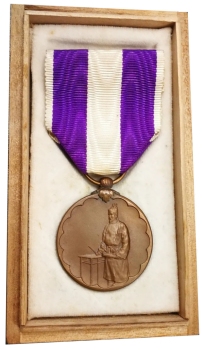
Not used in Korea
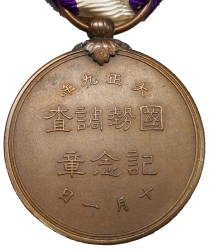
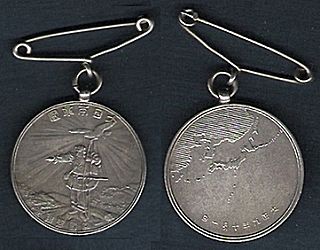
1925 Census Takers Badge
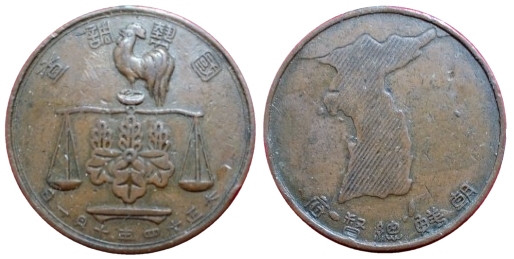
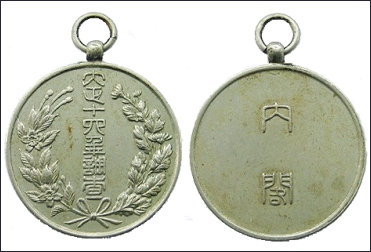
On the 1925 Census Takers Badge (left), the Obverse inscription is 大正十四年調査 Taisho 14th year (1925) Census Takers Badge (대정십사년조사). The Reverse inscription is 內閣 Ministry/Cabinet (내각).
The Obverse on the Korean Census Commemorative Medal (right) has a rocker inscription at the top which reads as 國勢調査 National Census (국세조사), and the rocker at the bottom is 大正十四年十月一日 Taisho 14th year, 10th month, 1st day (Oct. 1, 1920) (대정십사년십월일일). The Reverse inscription is 朝鮮總督府 Governor-General of Korea Administration (조선총독부). According to Nick at The Medals of Asia Website, these badges were manufactured by the Okubo Masatoshi Workshop 大久保眞敏商店 (대구보진민상점) located in Keijo (Seoul).
1930 Census Medal
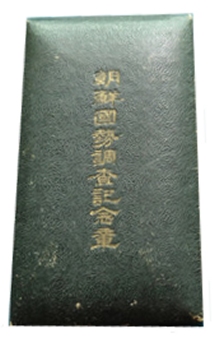
국세조사 기념장 (1930년)
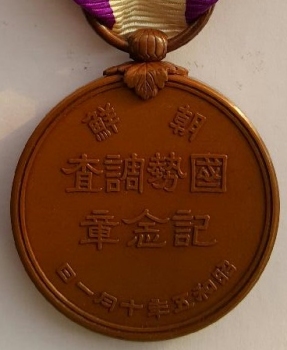
The Minister of Colonial Affairs (拓務大臣) was contemplating the possible issuance of a medal for the 1930 Census. On 6th December 6, 1931, the Colonial Affairs Ministry asked the Korean National Census Section Chief, what was the number of medals that would be needed if a medal was to be issued. The reply was that 64,101 people were directly involved in executing the census. On Dec. 17, 1931, Toyosuke Hata 秦 豊助 (1872-1933), the Minister of Colonial Affairs (拓務大臣), sent a letter to the Prime Minister requesting that the first national census in Korea also be commemorated with a medal of its own similar to the 1920 medal. The Prime Minister’s office forwarded the letter to the Decorations Bureau on 21st December, and the Decorations Bureau responded immediately on the 22nd that they had no objections. On December 23, the Cabinet approved the idea to issue a medal and the Decorations Bureau was asked to submit a draft of the edict and medal design. The Decoration Bureau’s proposal was presented to the Prime Minister on June 21, 1932. Article 3 of the Proposal said recipients were to be either: 1. Those directly involved in the 1930 Korean National Census, 2. Those involved in supporting activities related to the above and 3. Those who had already been awarded the 1920 National Census Medal were to be excluded. The medal was to be identical to the 1920 Census Medal, with only the wording on the reverse being different. The reverse inscription is 朝鮮 / 国勢調査 / 記念章 / 昭和5年10月一日 Korean / National Census / Commemorative Medal / Showa 5th (1930) Oct. 1. The cabinet gave design approval on July 4th, established the medal on July 7th, which was enacted by Hirohito as Imperial Edict #145 on July 18, 1932. The master mold is attributed to Kyushichi Miyajima 宮島久七 of the Osaka mint, who was a prolific artist, and was also active in the postwar years. All the award documents would have an October 1, 1930, date on them, and the cases were now pasteboard instead of the paulownia sandalwood boxes. These pasteboard boxes had become the new standard case material since the Showa Grand Ceremony Commemorative Medal of 1928. A total of 64,101 medals were manufactured/issued(?). At the end of World War II, Koreans in possession of this medal would trash them rather than being called 친일파2 “Chinilpa” (traitor). Many Japanese would also trash their medal because it reminded them of the Empire they lost. These medals are available, but at substantially higher prices than the 1920 Medal. The medals pasteboard boxes are even rarer.
For the 1930 Census Takers Badge, the Obverse inscription at the top is 朝鮮 Korea (조선). The vertical inscription is 國勢調査 National Census (국세조사). The Reverse inscription running down the center is 朝鮮總督府 Government-General of Korea (조선총독부), while the smaller inscription on either side of the center is 昭和五年十月一日 Showa 5th year, 10th month, 1st day (Oct. 1, 1930) (소화오년십월일일).

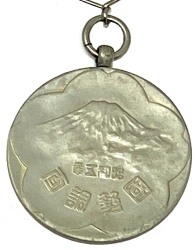
Not used in Korea
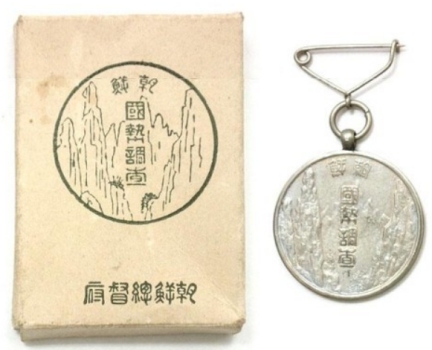
1935 Census Takers Badge
Established on April 13, 1935. The Obverse inscription has two rocker lines at the bottom, the upper rocker is 昭和十年 Showa year 10 (1935) (소화십년). The lower rocker is 國勢調査 National Census (국세조사). The Reverse inscription is 朝鮮總督府 Government-General of Korea (조선총독부).
Currently, the only known manufacturer for these badges was the Naigai Medal Co. 内外徽章製作所 in Tokyo. See Medals of Asia.
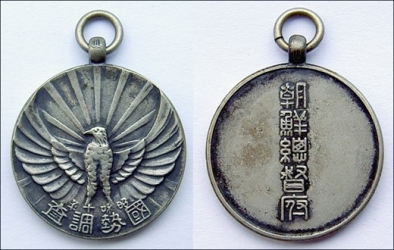

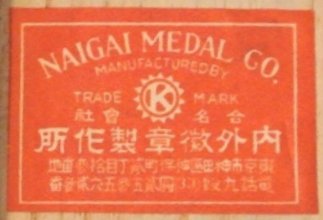
1940 Census Takers Badge
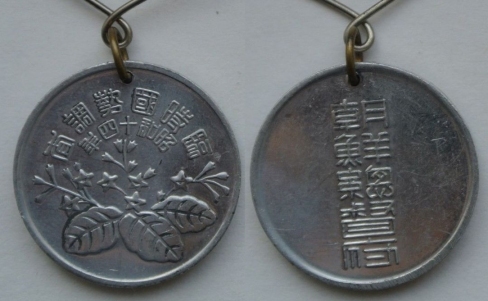
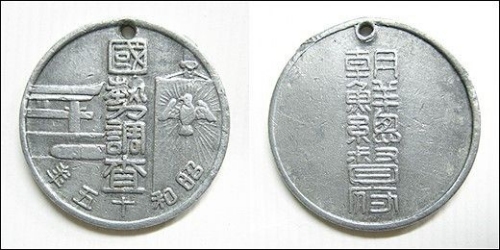
I have been unable to determine why there is a 1939 Temporary Census Takers Badge (left). The Obverse has two rockers at the top. The upper rocker is 臨時國勢調査임 Temporary National Census (임시국세조사). The lower rocker is the date 昭和十四年 Showa 14th year (1939) (소화십사년). The Reverse inscription is 朝鮮總督府 Government-General of Korea (조선총독부). I have seen examples of this badge where the Reverse inscription is 內閣 Ministry / Cabinet (내각).
The 1940 Census Takers Badge (right) has the Obverse inscription down the center is 國勢調査 National Census (국세조사) and the rocker at the bottom reads as 昭和十五年 Showa year 15 (1940) (소화십오년). The Reverse inscription is 朝鮮總督府 Government-General of Korea (조선총독부)
Footnotes:
- After the Republic of Korea was established, the lands formerly owned by the Oriental Development Company, within South Korean boundaries, were distributed to farmers by the 1949 Land Reform Act. Similar land distributions were done in North Korea, but did not convey ownership, only tenancy.
- Chinilpa 친일파 literally means “pro-Japan faction” and is a derogatory term that denotes ethnic Koreans who collaborated with Imperial Japan during the protectorate period and/or the colonial rule (1905 to 1945). They are considered “National Traitors”. A Special Committee for the Prosecution of Anti-National Offenders (반민특위) was set up in 1948 to prosecute the Chinilpa. In 2005, a “Special law to redeem pro-Japanese collaborators’ property” was passed.
